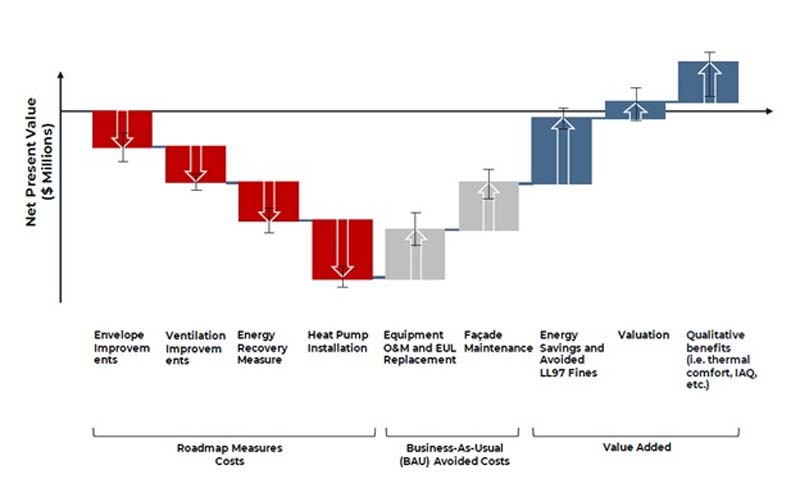Energy Efficiency, GHG Emissions - November 20, 2024 - By New York State Energy Research and Development Authority (NYSERDA)
NYSERDA: The Business Case for Decarbonization
Decarbonizing building operations and manufacturing requires a transformation in mindsets and capital planning to design projects that are cost-effective and aligned with organizational goals.
Commercial and industrial building owners—including those in hard-to-electrify sectors—can decarbonize and generate value through a phased, holistic approach: Resource Efficient Decarbonization (RED). There’s no one-size-fits-all pathway to decarbonization, which is why the RED framework focuses on energy reduction as a first step, while keeping multiple retrofit options open for building owners and managers as technology and regulation evolves.
The RED approach emerged from the Empire Building Challenge (EBC) through collaboration with early adopters and industry-leading firms implementing low-carbon retrofits in New York’s tallest buildings. Yet, this decarbonization framework and the lessons learned from EBC can be applied to commercial, multifamily, and industrial buildings of varying scales and uses across New York State.
Here is how facility managers and commercial and industrial leaders can make the business case for building decarbonization in their organization.
Shifting Mindsets to Reframe Decarbonization as a Business Opportunity
For organizations that view decarbonization investments purely as a cost and compliance liability, shifting mindsets to understand decarbonization as a business or economic opportunity is essential to create organizational buy-in and unlock long-term value beyond avoided compliance penalties (e.g., NYC’s Local Law 97).
“Misconceptions about decarbonization can delay action and progress on retrofit projects,” says Sophie Cardona, Senior Project Manager on NYSERDA’s Empire Building Challenge team. “The notion that one-to-one replacement of fossil fuel equipment with heat pumps, all at once, is the only way to fully decarbonize is one common misconception,” adds Cardona.
Instead, the RED framework puts forth a technologically agnostic approach to building electrification and decarbonization. In addition to considerations for space constraints and tenant disruption, the future availability of thermal energy networks and other decarbonization solutions, such as geothermal or wastewater heat recovery systems, could present more feasible alternatives to air source heat pumps in the case of large buildings.
When considering the value of energy efficiency and decarbonization projects, the conventional approach has typically called for using simple payback periods to assess the viability of a project. This is another common misconception, notes Cardona.
Rather, building owners should “think in terms of long-term capital planning based on a discounted cash flow analysis,” says Cardona. In other words, decision-makers should consider the net present value of decarbonization upgrades versus a business-as-usual scenario to determine a project’s return on investment. Net present value looks at future cash flows while factoring in the time value of money to evaluate the lifetime value of a project in today’s dollars.
According to Cardona, “the lens through which we look at decarbonization – short-term vs. long-term, systems in isolation vs. system integration, and simple payback vs. net present value – informs what building owners and managers think is possible.”
Moving past these misconceptions and following the RED framework, building owners have cost-effective and technologically sound solutions available to them today to begin reducing building energy loads and decarbonizing heating and cooling systems.
Taking Steps Toward Decarbonization
Understanding how facilities use energy, especially fossil fuels, is an important place to begin identifying challenges and opportunities for decarbonization.
A condition assessment should evaluate the building design, tenant turnover schedules, utility data, equipment operations and end-of-useful life, air quality and other environmental data, and the location and volume of wasted thermal energy. This assessment informs the specific engineering solutions and identifies the asset and market conditions that can support the achievement of decarbonization over time. It’s important to update this assessment often and share information between decision makers, asset managers, and facilities and engineering teams throughout the process.
Feedback from technical staff is essential to ensure proposed solutions have consensus and align with the organization’s workforce capacity and organizational priorities before moving forward. This is why the initial assessment should also factor asset-specific conditions, such as major tenant turnovers and vacancies, repositioning, recapitalization, building codes, and other capital event cycles.
The RED framework focuses on a phased approach with four steps to decarbonize a building’s thermal systems: reduce, reconfigure, reuse, and replace.
Reducing the building’s energy loads typically begins with envelope improvements, optimization of building systems and controls, and ventilation upgrades. These initial efficiency improvements lower energy costs in the near-term while allowing smaller future equipment sizing for a reduced peak energy load.
Reconfiguring building systems is an integral step to further lower energy consumption while preparing facilities for deeper decarbonization retrofits. Namely, building owners should prioritize shifting to low or moderate temperature heating and cooling, and strategically relocating distribution systems to enable heat recovery. For instance, high temperature steam heating can be gradually replaced with hydronic distribution to support heat pumps, which can add efficiency by repurposing waste heat and minimizing distribution system losses.
Facilities produce and lose heat from a variety of processes. Harnessing waste heat through airside or waterside recovery, wastewater, process heat or refrigeration, or other means offers significant energy and emissions savings for commercial and industrial buildings. Capturing waste heat leverages energy that’s already been paid for to be stored or repurposed for other uses, such as space or water heating.
After reducing energy loads and integrating heat recovery, building owners are well-positioned to start incrementally replacing fossil fuel equipment, including HVAC or domestic hot water systems, with all-electric technologies. Partial electrification efforts should prioritize equipment nearing the end of useful life and focus on serving loads that are easiest to electrify.
Full electrification is feasible for many building types and systems. However, electrifying peak loads for industrial facilities and larger buildings could require special consideration and accounting for an evolving electric grid, emerging technology, or preparing for the arrival of a thermal energy network supply.
Below is a conceptual representation of a business case illustrating a discounted cash flow analysis and comparing the potential costs and revenues of phased decarbonization under the RED framework with a business-as-usual scenario.

With any decarbonization project, it’s important to think beyond simple payback and consider how the net present value compares to the business-as-usual scenario. This includes accounting for avoided costs, such as equipment replacement, operation and maintenance costs, and the future cost of fossil fuels. The net present value should also account for energy savings, avoided penalties, and non-energy benefits that align with a building’s sustainability goals (e.g., indoor air quality) or increase the property value.
This economic and financial analysis informs the decarbonization pathways offering the lowest marginal cost: the incremental cost between the projects and the business-as-usual scenario.
Catalyzing Action on Decarbonization
Reframing mindsets and holistic capital planning are fundamental steps to developing a decarbonization strategy for commercial, industrial, and multifamily buildings. Keep in mind that decarbonization decisions evolve over time. Beginning with energy load reduction and reconfiguring systems to enable multiple decarbonization pathways (i.e., retaining future optionality) can help organizations start making progress and adding value before committing to a plan for full electrification.
Multiple Empire Building Challenge projects produced a positive net present value for their decarbonization plans. Leveraging Inflation Reduction Act tax credits for energy efficiency improvements and clean energy technologies can further reduce the marginal cost of decarbonization projects against a business-as-usual scenario.
Before implementing a decarbonization project, commercial and industrial properties can access cost-share technical support through NYSERDA’s FlexTech Program to complete a site-specific energy study. Additionally, property owners can tap into funding through NYSERDA’s Heat Recovery Program to evaluate a building’s heat recovery potential or design and implement a heat recovery project.
As commercial and industrial leaders begin their decarbonization planning, NYSERDA’s building experts can help organize and facilitate a decarbonization design charette to collaboratively review, identify, and prioritize solutions to advance progress.
This column originally appeared on the NYSERDA website.
 NYSERDA offers objective information and analysis, innovative programs, technical expertise, and support to help New Yorkers increase energy efficiency, save money, use renewable energy, and reduce reliance on fossil fuels. A public benefit corporation, NYSERDA has been advancing energy solutions and working to protect the environment since 1975.
NYSERDA offers objective information and analysis, innovative programs, technical expertise, and support to help New Yorkers increase energy efficiency, save money, use renewable energy, and reduce reliance on fossil fuels. A public benefit corporation, NYSERDA has been advancing energy solutions and working to protect the environment since 1975.
Share this valuable information with your colleagues using the buttons below:
« Back to ColumnsStay Up-To-Date












